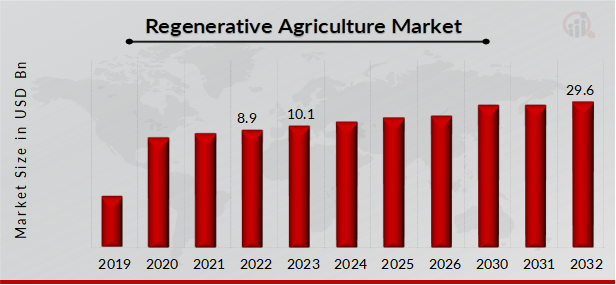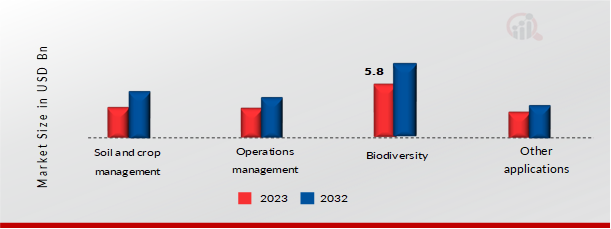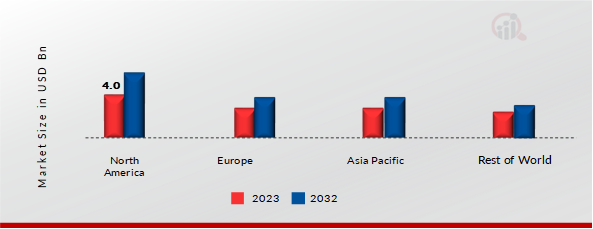Global Regenerative Agriculture Market Overview
Regenerative Agriculture Market Size was valued at USD 8.9 Billion in 2022. The Regenerative Agriculture Market industry is projected to grow from USD 10.1 Billion in 2023 to USD 29.6 Billion by 2032, exhibiting a compound annual growth rate (CAGR) of 14.30% during the forecast period (2024 - 2032). The increasing demand for premium foods and food products, the necessity to decrease carbon emissions, enhance soil health and water cycles, and the rapidly expanding population are expected to be significant market drivers for the regenerative agriculture market.

Source: Secondary Research, Primary Research, MRFR Database and Analyst Review
Regenerative Agriculture Market Trends
- Increasing consumer demand for sustainable agriculture practices and rising demand for organic and natural food products are driving the market growth
The market CAGR for Regenerative Agriculture is driven by the increasing consumer demand for sustainable agriculture practices and rising demand for organic and natural food products. As consumer awareness about environmental issues grows, there is a growing demand for sustainable and ethical food production methods. This increasing demand has fueled the adoption of regenerative agriculture, which is seen as a more sustainable and environmentally friendly farming approach. In India, crop rotation is the most widely adopted sustainable agriculture practice, covering approximately 30 million hectares (Mha) of land and involving around 15 million farmers. Agroforestry, primarily favored by large-scale cultivators and rainwater harvesting, has substantial coverage, with 25 Mha and 20-27 Mha, respectively. Natural farming is emerging as the fastest-growing sustainable agricultural practice in India, with around 800,000 farmers adopting it. Integrated Pest Management (IPM) has also gained significant coverage, reaching 5 Mha after years of consistent promotion. Consumers are increasingly willing to pay a premium for products produced using regenerative practices, leading to a rise in the number of farmers embracing these methods. Moreover, many companies are now investing in regenerative agriculture to meet consumer demands and enhance their sustainability credentials.
There is a rising consumer preference for food products that are organic, natural and sustainably produced, leading to an increased demand for products cultivated using regenerative agriculture methods. These practices are perceived as healthier, more environmentally friendly and of higher quality. According to a 2022 survey conducted in 187 countries practicing organic agriculture by the Research Institute of Organic Agriculture (FiBL) and the International Federation of Organic Agriculture Movements (IFOAM), India ranks fifth globally in organic food cultivation, covering 2.6 million hectares. The survey also indicates that India's organic farming land constitutes 1.5% of the total agricultural land, with a remarkable 145.1% increase in the past decade. The Economic Survey 2022-2023 reports that India boasts the highest number of organic farmers globally, totaling 4.43 million. Consequently, many food producers and retailers are now sourcing ingredients from regenerative agriculture farms and investing in regenerative agriculture practices to meet this growing demand.
As a result, it is anticipated that throughout the projection period, demand for the Regenerative Agriculture Market will increase due to the Increasing Consumer Demand for Sustainable Agriculture Practices and Rising demand for organic and natural food products. Thus, driving the Regenerative Agriculture Market revenue.
Regenerative Agriculture Market Segment Insights
Regenerative Agriculture Market Practice Insights
The Regenerative Agriculture Market segmentation, based on Practice includes Agroecology, Agroforestry, Biochar & Terra Preta, holistically managed grazing, No-till and pasture cropping, Silvopasture and other practices. The Agroforestry segment dominated the market, accounting for 58% of market revenue. Agroforestry plays a pivotal role in this sector by integrating trees, crops and livestock within a unified farming system. This approach has garnered significant attention in recent years for its ability to bolster soil health, foster biodiversity and elevate the overall sustainability of agricultural operations. Within the framework of regenerative agriculture, agroforestry emerges as a fundamental strategy for promoting environmentally sound and economically viable farming practices. By incorporating trees into the farming landscape, farmers can offer additional benefits such as shade, windbreaks and erosion control. Furthermore, the presence of tree roots enhances soil structure and augments water infiltration, thereby enhancing soil health and boosting productivity.
Regenerative Agriculture Market Application Insights
The Regenerative Agriculture Market segmentation, based on the Application includes Soil and crop management, (Nitrogen fixation, Water retention, Nutrient cycle), Operations management (Carbon sequestration, Ecosystem services), Biodiversity and other applications. The Biodiversity segment dominated the market, accounting for 58% of market revenue. Regenerative agriculture plays a vital role in conserving biodiversity by fostering a symbiotic connection between agriculture and the environment. Through practices like crop rotation, cover cropping and diversified plantings, regenerative agriculture nurtures a wide array of plant and animal species, thereby promoting biodiversity conservation and growth. By cultivating a diverse soil microbial community, regenerative agriculture enhances nutrient cycling, disease resilience and overall soil health, further contributing to the preservation of biodiversity.
Figure 1: Regenerative Agriculture Market, by Application, 2023 & 2032 (USD Billion)

Source: Secondary Research, Primary Research, MRFR Database and Analyst Review
Regenerative Agriculture Market Regional Insights
By region, the study provides market insights into North America, Europe, Asia-Pacific and the Rest of the World. The anticipated expansion of the Regenerative Agriculture market in North America can be attributed to several key factors. In December 2022, the Rockefeller Foundation revealed an $11 million grant allocated to organizations supporting Indigenous and regenerative agriculture initiatives. Numerous factors fueling the growth of the regenerative agriculture market include corporate backing for regenerative farming methods, increasing consumer demand for sustainable and nutritious food, technological advancements and governmental incentives and policies. Additionally, in March 2023, PepsiCo disclosed a $216 million investment in long-term strategic partnerships with three prominent farmer-focused organizations: Soil and Water Outcomes Fund (SWOF), Practical Farmers of Iowa (PFI) and the IL Corn Growers Association (ICGA). These partnerships aim to drive the adoption of regenerative agriculture practices throughout the United States.
Further, the major countries studied in the market report are the US, Canada, Germany, France, the UK, Italy, Spain, China, Japan, India, Australia, South Korea and Brazil.
Figure 2: REGENERATIVE AGRICULTURE MARKET SHARE BY REGION 2023 (USD Billion)

Source: Secondary Research, Primary Research, MRFR Database and Analyst Review
Europe's Regenerative Agriculture Market accounts for the second-largest market share as The European Agroforestry Federation (EURAF) advocates for the integration of trees into agricultural landscapes and various forms of silvopastoral systems across diverse environmental regions in Europe. With over 500 members spanning 20 European countries, EURAF's presence contributes to the expansion of the agroforestry market in the region. Organic farming practices, which involve reduced pesticide usage and enhanced carbon sequestration in the soil, are gaining popularity. In 2022, the total organic farmland area in the EU increased to 10.1 million hectares, with the number of organic producers rising by 10.8% to 419,112 compared to 2021. Experts suggest that transitioning to regenerative farming methods can help decrease climate emissions in the UK. In November 2021, General Mills launched its first regenerative agriculture project in Europe to support dairy farmers supplying milk for Häagen-Dazs ice cream. Further, the German Regenerative Agriculture Market held the largest market share and the UK Regenerative Agriculture Market was the fastest-growing market in the European region.
The Asia-Pacific Regenerative Agriculture Market is expected to grow at the fastest CAGR from 2024 to 2032. The market's growth in this region is driven by factors like heightened consumer awareness regarding the advantages of sustainable agricultural practices and the growing demand for organic and sustainable food items. According to APEDA, India produced 2.9 MMT of certified edible organic products for MY 2022/23. As of March 31, 2023, India's APEDA reports that the organic certification area in India under NPOP is 10.17 million hectares (MHA), encompassing 5.4 mha of cultivable areas and 4.7 mha of wild harvest collection. According to the Research Institute of Organic Agriculture, India had the highest number of organic producers globally and ranked 6th in the world for organic agricultural land in 2021. Furthermore, the region's growing population has led to increased food demand, driving the adoption of sustainable agriculture practices. Additionally, the Chinese government has rolled out various initiatives to promote sustainable agriculture practices, such as the Soil Ten Plan, aimed at reducing pollution and enhancing soil health. Moreover, China’s Regenerative Agriculture Market held the largest market share and the Indian Regenerative Agriculture Market was the fastest-growing market in the Asia-Pacific region.
Regenerative Agriculture Key Market Players & Competitive Insights
Leading market players are investing heavily in research and development to expand their product lines, which will help the Regenerative Agriculture market, grow even more. Market participants are also undertaking a variety of strategic activities to expand their footprint, with important market developments including new product launches, contractual agreements, mergers and acquisitions, higher investments and collaboration with other organizations. To expand and survive in a more competitive and rising market climate, the Regenerative Agriculture industry must offer cost-effective items.
Manufacturing locally to minimize operational costs is one of the key business tactics used by manufacturers in the Regenerative Agriculture industry to benefit clients and increase the market sector. In recent years, the Regenerative Agriculture industry has offered some of the most significant advantages to the environment, farmers and society as a whole. Major players in the Regenerative Agriculture Market, including Nestle SA (Switzerland), Danone SA (France), General Mills, Inc (US), Cargill Incorporated (US), Unilever PLC (United Kingdom), Grounded (South Africa), Soil Capital Belgium SPRL (Belgium), Indigo Ag, Inc (US) and Serenity Kids (US) are attempting to increase market demand by investing in research and development operations.
Nestle SA, a prominent food and beverage manufacturer, offers a wide range of products, including baby food, bottled water, cereals, chocolates, coffee and culinary items, among others. The company also caters to plant-based foods, dairy products, ice cream and pet care. Nestle's diverse product portfolio includes popular brands such as Nescafe, Nespresso, Maggi, Kit Kat and Purina, among others. Operating globally, Nestle has a significant presence across Asia, Oceania, the Americas, Europe, the Middle East and Africa, with its headquarters in Vevey, Waadt, Switzerland. In July 2023, Nestlé initiated a project aimed at assisting wheat farms in adopting regenerative agriculture practices within the supply chain for its DiGiorno pizza brand. This initiative aims to enhance biodiversity, reduce water and energy consumption, minimize fertilizer usage and enhance soil health and fertility while addressing the impacts of climate change.
General Mills Inc. is a leading manufacturer and marketer of branded consumer foods, offering a diverse range of products, including grains, fruits, savories, nutrition bars, frozen snacks, cereals, pet food, dough products, baking mixes, yogurt and premium ice cream. The company's product lineup also includes convenient meal options like meal kits, ethnic meals, pizza, soup and breakfast items. General Mills markets its products under various well-known brand names such as Cheerios, Chex, Cocoa Puffs, Fiber One, Go-Gurt, Gold Medal and many others. Operating across Asia, the Middle East, Africa, Europe, North America and Latin America, General Mills is headquartered in Minneapolis, Minnesota, USA. In June 2022, General Mills partnered with Regrow Agriculture to monitor agricultural practices and their environmental impacts across 175 million acres of farmland in North America, Latin America and Europe.
Key companies in the Regenerative Agriculture Market include
- Nestle SA (Switzerland)
- Danone SA (France)
- General Mills, Inc (US)
- Cargill Incorporated (US)
- Unilever PLC (United Kingdom)
- Grounded (South Africa)
- Soil Capital Belgium SPRL (Belgium)
- Indigo Ag, Inc (US)
- Serenity Kids (US)
Regenerative Agriculture Industry Developments
October 2022: Nestle SA (Switzerland) launched NESCAFÉ Plan 2030, aimed at promoting regenerative agriculture, reducing greenhouse gas emissions and enhancing farmers' livelihoods. The brand plans to invest over one billion Swiss francs by 2030 in the NESCAFE Plan 2030, building upon its existing sustainability efforts. This investment is backed by Nestlé's regenerative agriculture financing, following the company's commitment to accelerating the transition to a regenerative food system and its ambition to achieve zero net greenhouse gas emissions.
June 2022: General Mills (US) partnered with Regrow Agriculture (Australia) to monitor agricultural practices and their environmental impacts across 175 million acres of farmland in North America, Latin America and Europe. Regrow Agriculture is also supporting General Mills' commitment to promoting regenerative agriculture on 1 million acres of farmland by 2030
Regenerative Agriculture Market Segmentation
Regenerative Agriculture Market Practice Outlook
- Agroecology
- Agroforestry
- Biochar & Terra Preta
- Holistically managed grazing
- No-till and pasture cropping
- Silvopasture
- Other practices
Regenerative Agriculture Market Application Outlook
- Soil and crop management
- Nitrogen fixation
- Water retention
- Nutrient cycle
- Operations management
- Carbon sequestration
- Ecosystem services
- Biodiversity
- Other applications
Regenerative Agriculture Market Regional Outlook
-
- Germany
- France
- UK
- Italy
- Spain
- Rest of Europe
- Asia-Pacific
- China
- Japan
- India
- Australia
- South Korea
- Australia
- Rest of Asia-Pacific
- Rest of the World
- Middle East
- Africa
- Latin America
| Report Attribute/Metric |
Details |
| Market Size 2022 |
USD 8.9 Billion |
| Market Size 2023 |
USD 10.1 Billion |
| Market Size 2032 |
USD 29.6 Billion |
| Compound Annual Growth Rate (CAGR) |
14.30% (2024-2032) |
| Base Year |
2023 |
| Market Forecast Period |
2024-2032 |
| Historical Data |
2019-2022 |
| Market Forecast Units |
Value (USD Billion) |
| Report Coverage |
Revenue Forecast, Market Competitive Landscape, Growth Factors and Trends |
| Segments Covered |
Practice, Application and Region |
| Geographies Covered |
North America, Europe, Asia Pacific and the Rest of the World |
| Countries Covered |
The US, Canada, Germany, France, UK, Italy, Spain, China, Japan, India, Australia, South Korea and Brazil |
| Key Companies Profiled |
Nestle SA (Switzerland), Danone SA (France), General Mills, Inc (US), Cargill Incorporated (US), Unilever PLC (United Kingdom), Grounded (South Africa), Soil Capital Belgium SPRL (Belgium), Indigo Ag, Inc (US) and Serenity Kids (US) |
| Key Market Opportunities |
The increasing demand for sustainable food production systems |
| Key Market Dynamics |
Rising awareness regarding the environmental impacts of conventional farming techniques |
Frequently Asked Questions (FAQ) :
The Regenerative Agriculture Market size was valued at USD 10.1 Billion in 2023.
The Regenerative Agriculture Market is projected to grow at a CAGR of 14.30% during the forecast period, 2024-2032.
North America had the largest share of the market
The key players in the market are Nestle SA (Switzerland), Danone SA (France), General Mills, Inc (US), Cargill Incorporated (US), Unilever PLC (United Kingdom), Grounded (South Africa), Soil Capital Belgium SPRL (Belgium), Indigo Ag, Inc (US) and Serenity Kids (US)
The Agroforestry segment dominated the market in 2023.
The Biodiversity segment had the largest share in the market.





























